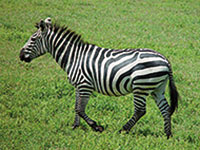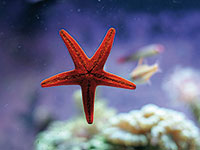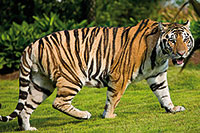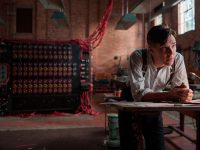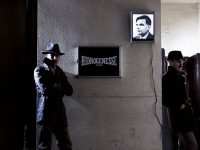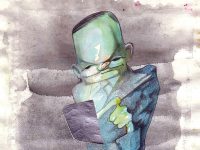
|
Turing’s influence on biology has taken a long time to emerge, but it is now beginning to grow and become important. Since Turing’s most outstanding and well-known contribution refers to the beginnings of computer theory and its use in the foundations of mathematics issues, some might think that his influence might be embodied mainly in areas related to the study of the brain, but it does not. Indeed, with regards to the structure of the brain, it seems he tries to avoid it; he places the subject of machine intelligence in the context of the simulation, that is, he proposes that a machine is intelligent if all its responses and reactions are indistinguishable from those of an intelligent person, without making any reference to the internal structure of the machine or the brain. Turing’s influence on biology comes from the article published in 1952 in Proceedings of the Royal Society, «The chemical basis of morphogenesis», in a field that is very different from the brain’s. That contributes to his interest as a scientific figure, since it presents him as an even more versatile, restless and creative mind than we could think if we ignored this very important work. This article has been cited about 5,700 times so far – sixty years after being published, on 14th August 1952 — but during the first twenty years it was quoted only 130 times, and another 250 times during the twenty following years. We see, then, that the pace of citations has been very uneven: hesitant in the beginning and plentiful in the past twenty years. These rhythms don’t pale into insignificance, but they are, in fact, an answer to the evolution of scientific circumstances during this period. In this article, we will explain what Turing’s contribution was and how the outlook of his influence has been changing over time. HISTORtY The problem addressed by Turing in his 1952 work was morphogenesis, that is, cell differentiation and the formation of spatial biological patterns which may lead to different tissues and organs. This subject is, naturally, one of the most fascinating in biology: how does the orderly and careful differentiation and structuring of the organisms form and unfold from an initial cell? How is it that if all cells of an organism have the same genetic information, some read some parts and others read other parts? How does one go from purely local genetic instructions to structures formed by millions of cells? Turing was attracted by this problem because of his interest in nature, which he carefully watched on his walks through the countryside, and in the brain – how are grooves and convolutions formed? How are the different parts of the brain connected? How does the hierarchy of actions form? –. But other works also had an influence on him: On growth and form by D’Arcy Thompson, published in 1917 and reissued with some frequency since then, and What is life?, which compiled the famous series of lectures given by Schrödinger in Dublin in 1944. The first book describes the forms of shells, horns, flowers, branches, insects, fishes, and the changes experienced during their growth. When possible, Thompson tries to express some mathematical characteristics of these forms and analyses the laws of scale they present, but he formulates no specific ideas about the genetic mechanisms that make them appear. The book combines the formal beauty of nature with a deep reflection on its basic mechanisms and its mathematical echoes, but without yet connecting the ones with the others. For his part, Schrödinger talks in What is life? about some physical issues related to life, in particular the apparent discrepancy with the second law of thermodynamics, which implies the disruption and disappearance of structures in isolated systems, rather than the biological structuring. As in D’Arcy Thompson’s book, therefore, the structuring problem is also central in Schrödinger’s book. Among his ideas the proposal of an «aperiodic crystal» as a hypothetical bearer of genetic information stands out. In 1953, the discovery of the structure of the DNA and the chemical complementarity between its two chains brought this «aperiodic crystal» to light, and vigorously initiated molecular biology. THE CHEMICAL BASIS OF MORPHOGENEsiS Turing proposes that morphogenesis is a consequence of the action of molecules, which he calls morphogens, which are disseminated through the organism and react chemically with each other, and whose concentration determines the speeds of growth of organs and tissues. The idea is not entirely new. Waddington, cited in Turing’s work, had already introduced the idea of organiser molecules that were produced by some cells and spread out throughout the body. Thus, the other cells «knew» their position in the organism depending on the concentration of these molecules: the closer to the producer cell, the larger the cell concentration (model of the gradient, as it is often called). Turing’s new contribution is that this type of molecules can react with each other, and the mathematical exploration of the possibilities arising from the corresponding reaction-diffusion model. The most striking point of Turing’s model is the spontaneous rupture of homogeneity in the initial system, leading to the emergence of a wide variety of geometric patterns. Unlike the gradient model, in which from the beginning spatial symmetry was broken by the presence of a few privileged reference cells, in Turing’s model, symmetry is spontaneously broken, and the patterns to which it leads have their own spatial and temporal scale, independent from system size. Although Turing did not know the chemical identity of morphogens and their molecular mechanisms, he reached some generic conclusions, for example: that in continuous systems at least two morphogens are needed, with quite different diffusion constants, or that the molecules of slow diffusion are the ones that stimulate the production of other molecules, while those that stimulate the destruction of molecules spread quickly. Subsequently, the idea of the spontaneous rupture of symmetry will have great relevance in areas such as elementary particle physics and the materials physics, but without Turing’s influence having a role. Mathematically speaking, Turing’s work is very rich and subtle, especially with regards to the study of the stability of the set of non-linear and coupled differential equations, and the classification of various types of instabilities and patterns. In particular, Turing studies instabilities in a closed loop of cells and notes how it can go from a homogeneous situation to a periodic situation in space, as a result of the accumulation of morphogens at regular intervals. That could explain, for example, the regularity of the number of arms in starfish, of the leaves emerging from a stem or the petals of a flower. And he also studies two-dimensional issues: on a plane (the emergence of patterns of spots or stripes in the skin of an animal or with skin diseases) or on a spherical surface (the process of gastrulation in the initial stages of the embryonic development). |
«Morphogenesis one of the most fascinating subjects in biology: how do the differentiation and structuring of the organisms form and unfold from an initial cell?»
|
|
|
|
«Turing proposes that morphogenesis is a consequence of the action of molecules, which are disseminated through the organism and react chemically with each other» | |
|
INFLUENCE Turing died in 1954, less than two years after the publication of the work that we are talking about. As I said, during the first twenty years this work is hardly influential, not very cited. What causes this limited influence is, on the one hand, the poor mathematical tradition of biologists, who are more focused on the morphological observation and the biochemical analysis than in the quantitative formulation of its subjects. In addition, it has been very difficult to identify specific morphogens, that is, molecules that actually play the role that Turing proposed. In fact, until 1990 it was not possible to observe a real stationary pattern in which the molecules could be identified – and it was not a biological system, but a much simpler system of non-biological chemical reactions. The problem is largely getting molecules with quite different diffusion constants. Furthermore, since 1953 molecular biology has focused on DNA rather than on development issues. On the other hand, the diffusion model is not clear enough in tissue biology, since the molecules have to move from cell to cell through membranes which make it difficult to transport them. Although until 1970 the article was quoted only by a few, his influence increased considerably between 1970 and 1990 as a result of the work of Ilya Prigogine and his theory on dissipative structures, that is, structures whose formation and maintenance requires a continuous input of energy, unlike classical structures such as those of crystals, which can be kept indefinitely in isolated systems, provided that the temperature is kept below certain values. Turing’s work is an excellent example of dissipative structures, since for the trend towards structuring to predominate over the trend to homogenising dissemination concentrations of morphogen quite far from those corresponding to chemical balance are needed. Therefore, Turing’s work is very influential to Prigogine, who generalised the idea of an order far from balance, not just in problems of reaction-diffusion but also of conduction-convection of heat (Bénard-Marangoni structures) and other situations. Prigogine was more interested in the generic idea of the appearance of structures than in their specific form. The centre of his interest is thermodynamics and, in particular, the idea that a certain degree of alienation with respect to equilibrium conditions is essential for the production and maintenance of the dissipative structures. This means a considerable progress with respect to the vision that Schrödinger exposed in What is life? Another scientist very interested in morphogenesis and influenced by Turing is the mathematician René Thom, and his catastrophe theory. Since approximately the year 1990, the influence of Turing’s work grows as a result of the widespread use of computers, and the increase of techniques and strategies of simulation in biology and other fields. Indeed, although the forms patterns deduced by Turing’s equations resemble the patterns of biological forms a lot – in some cases – that fact took a while to be known, because computers are needed to view the solutions of the equations. The increase in the interest in development and its relation with evolution has been another of the stimuli to become interested in Turing’s proposals. Thus, although the number of systems where it has actually been possible to identify morphogens (usually proteins) and their respective reactions is small, Turing’s model – heavily corroborated in simulations – became increasingly plausible. On the other hand, Turing’s idea has expanded and includes, in addition to chemical effects, mechanical, electrical and thermal actions, which infuse it with versatility and authenticity. The step from theoretical patterns of equations to real patterns that we observe in nature is not only a problem of development but also of evolution. If the pattern makes the individual more visible and vulnerable, that pattern will be eliminated and we will not find it, not because it is not physically possible, but because it is not biologically advantageous. Reciprocally, if it is not physically possible it will not be found, but this will not be the result of evolution. Therefore, Turing’s explanation is just one aspect of a wider problem. Thus, apart from the particular interest it offers, Turing’s work makes us reflect on the relationship between biology and mathematical models – in the field of development, but also in the field of evolution and the origin of life. Mathematical models may be quite plausible and lead to solutions that reflect what is observed, but if it is not possible to identify the molecules and mechanisms, it is not fully good for biology – and if we do not know how to modify it, it is of no use to pharmacology or medicine. That does not mean that they are not useful: they show what to search for and provide a mental framework to structure questions and make them more fruitful. References David Jou. Department of Physics, Autonomous University of Barcelona. |
|
Bibliografia
Diversos autors, 2012. «Alan Turing at 100». Nature, 482 (23-02-2012).
Diversos autors, 2012. La ciencia después de Alan Turing. Col. «Temas», 68, Investigación y Ciencia. Barcelona (2012-09-04).
Hodges, A., 1992. Alan Turing: The Enigma. Vintage. Londres.
von Neumann, J. i A. M. Turing, 2009. L’ordinador i el cervell/Els ordinadors i la intel·ligència. Obrador Eddendum/ Edicions URV. Santa Coloma de Queralt.
Nicolis, G. i I. Prigogine, 1977. Self-Organization in Nonequilibrium Systems: From. Dissipative Structures to Order through Fluctuations. J. Wiley. Nova York.
Thom, R., 1985. Parabolas y catástrofes. Sèrie «Metatemas». Tusquets. Barcelona.
Turing, A., 1952. «The Chemical Basis of Morphogenesis». Proceedings of the Royal Society, B 237: 37-72.


